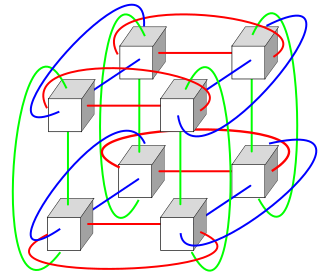Related Research Articles

A supercomputer is a computer with a high level of performance as compared to a general-purpose computer. The performance of a supercomputer is commonly measured in floating-point operations per second (FLOPS) instead of million instructions per second (MIPS). Since 2017, there are supercomputers which can perform over a hundred quadrillion FLOPS (100 petaFLOPS, 100 PFLOPS, or 1017 FLOPS). Since November 2017, all of the world's fastest 500 supercomputers run Linux-based operating systems. Additional research is being conducted in China, the United States, the European Union, Taiwan and Japan to build faster, more powerful and technologically superior exascale supercomputers.

Fujitsu Limited is a Japanese multinational information technology equipment and services company headquartered in Tokyo, Japan. In 2018, it was the world's fourth-largest IT services provider measured by global IT services revenue. Fortune named Fujitsu as one of the world's most admired companies and a Global 500 company.

Blue Gene is an IBM project aimed at designing supercomputers that can reach operating speeds in the petaFLOPS (PFLOPS) range, with low power consumption.

The Scalable Coherent Interface or Scalable Coherent Interconnect (SCI), is a high-speed interconnect standard for shared memory multiprocessing and message passing. The goal was to scale well, provide system-wide memory coherence and a simple interface; i.e. a standard to replace existing buses in multiprocessor systems with one with no inherent scalability and performance limitations.

Quadrics was a supercomputer company formed in 1996 as a joint venture between Alenia Spazio and the technical team from Meiko Scientific. They produced hardware and software for clustering commodity computer systems into massively parallel systems. Their highpoint was in June 2003 when six out of the ten fastest supercomputers in the world were based on Quadrics' interconnect. They officially closed on June 29, 2009.

The TOP500 project ranks and details the 500 most powerful non-distributed computer systems in the world. The project was started in 1993 and publishes an updated list of the supercomputers twice a year. The first of these updates always coincides with the International Supercomputing Conference in June, and the second is presented at the ACM/IEEE Supercomputing Conference in November. The project aims to provide a reliable basis for tracking and detecting trends in high-performance computing and bases rankings on HPL, a portable implementation of the high-performance LINPACK benchmark written in Fortran for distributed-memory computers.
The QCDOC is a supercomputer technology focusing on using relatively cheap low power processing elements to produce a massively parallel machine. The machine is custom-made to solve small but extremely demanding problems in the fields of quantum physics.

The SGI Origin 2000 is a family of mid-range and high-end server computers developed and manufactured by Silicon Graphics (SGI). They were introduced in 1996 to succeed the SGI Challenge and POWER Challenge. At the time of introduction, these ran the IRIX operating system, originally version 6.4 and later, 6.5. A variant of the Origin 2000 with graphics capability is known as the Onyx2. An entry-level variant based on the same architecture but with a different hardware implementation is known as the Origin 200. The Origin 2000 was succeeded by the Origin 3000 in July 2000, and was discontinued on June 30, 2002.
QPACE is a massively parallel and scalable supercomputer designed for applications in lattice quantum chromodynamics.
The SPARC64 V (Zeus) is a SPARC V9 microprocessor designed by Fujitsu. The SPARC64 V was the basis for a series of successive processors designed for servers, and later, supercomputers.

The Cray XE6 made by Cray is an enhanced version of the Cray XT6 supercomputer, officially announced on 25 May 2010. The XE6 uses the same computer blade found in the XT6, with eight- or 12-core Opteron 6100 processors giving up to 3,072 cores per cabinet, but replaces the SeaStar2+ interconnect router used in the Cray XT5 and XT6 with the faster and more scalable Gemini router ASIC. This is used to provide a 3-dimensional torus network topology between nodes. Each XE6 node has two processor sockets and either 32 or 64 GB of DDR3 SDRAM memory. Two nodes share one Gemini router ASIC.

The K computer – named for the Japanese word/numeral "kei" (京), meaning 10 quadrillion (1016) – was a supercomputer manufactured by Fujitsu, installed at the Riken Advanced Institute for Computational Science campus in Kobe, Hyōgo Prefecture, Japan. The K computer was based on a distributed memory architecture with over 80,000 compute nodes. It was used for a variety of applications, including climate research, disaster prevention and medical research. The K computer's operating system was based on the Linux kernel, with additional drivers designed to make use of the computer's hardware.

Japan operates a number of centers for supercomputing which hold world records in speed, with the K computer becoming the world's fastest in June 2011.

Approaches to supercomputer architecture have taken dramatic turns since the earliest systems were introduced in the 1960s. Early supercomputer architectures pioneered by Seymour Cray relied on compact innovative designs and local parallelism to achieve superior computational peak performance. However, in time the demand for increased computational power ushered in the age of massively parallel systems.

A torus interconnect is a switch-less network topology for connecting processing nodes in a parallel computer system.
The PRIMEHPC FX10 is a supercomputer designed and manufactured by Fujitsu. Announced on 7 November 2011 at the Supercomputing Conference, the PRIMEHPC FX10 is an improved and commercialized version of the K computer, which was the first supercomputer to obtain more than 10 PFLOPS on the LINPACK benchmark. In its largest configuration, the PRIMEHPC FX10 has a peak performance 23.2 PFLOPS, power consumption of 22.4 MW, and a list price of US$655.4 million. It was succeeded by the PRIMEHPC FX100 with SPARC64 XIfx processors in 2015.

Message passing is an inherent element of all computer clusters. All computer clusters, ranging from homemade Beowulfs to some of the fastest supercomputers in the world, rely on message passing to coordinate the activities of the many nodes they encompass. Message passing in computer clusters built with commodity servers and switches is used by virtually every internet service.

QPACE 2 is a massively parallel and scalable supercomputer. It was designed for applications in lattice quantum chromodynamics but is also suitable for a wider range of applications..

Fugaku(Japanese: 富岳) — named after an alternative name for Mount Fuji — is a petascale supercomputer at the RIKEN Center for Computational Science in Kobe, Japan. It started development in 2014 as the successor to the K computer, and it is scheduled to start operating in 2021, although parts of the computer were put into operation in June 2020. It is the fastest supercomputer in the world in the TOP500 list.
The A64FX is an ARM architecture microprocessor designed by Fujitsu. The processor is replacing the SPARC64 V as Fujitsu's processor for supercomputer applications. It is powering the Fugaku supercomputer.
References
- ↑ "Riken Advanced Institute for Computational Science" (PDF). Riken. Archived from the original (PDF) on 27 July 2011. Retrieved 20 June 2011.
- ↑ "Programming on K computer" (PDF). Fujitsu. Retrieved 24 June 2011.
- ↑ "Open MPI powers 8 petaflops". Cisco Systems. Archived from the original on 28 June 2011. Retrieved 24 June 2011.
- ↑ Yuichiro Ajima; et al. (2009). "Tofu: A 6D Mesh/Torus Interconnect for Exascale Computers". Computer. IEEE Computer Society. 42 (11): 36–40. doi:10.1109/MC.2009.370. S2CID 2049404.